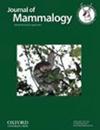从后院到野外:哺乳动物群落在城市化梯度中的变化
IF 1.5
3区 生物学
Q2 ZOOLOGY
引用次数: 0
摘要
城市化往往导致生物多样性的丧失和同质化,但这一结果并不普遍,城市化对野生动物的时空影响在不同城市和分类群之间存在很大的差异。人口和住房密度较低的地区是美国西部一些增长最快的地区;因此,在这些领域进行更多的研究可以进一步了解城市化对野生动物的影响,以及野生空间在维持发达地区周围生物群落多样性方面的潜在重要性。为了满足这一需求,我们进行了一项研究,以确定城市化(即住房密度)对蒙大拿州米苏拉市从荒野到郊区的住房密度梯度上的哺乳动物的影响。从2019年5月至10月至2020年,我们在城市/郊区、远郊、农村和野生地区的随机地点部署了178台运动激活跟踪摄像机。我们确定了所有哺乳动物>150 g,然后使用多物种占用模型评估住房密度如何影响:(i)占用和(ii)物种丰富度;(iii)使用泊松模型的相对丰度;(iv)利用核密度估计和逻辑回归分析了昼夜活动模式。城市化是哺乳动物分布的最大驱动力,随着住房密度的增加,哺乳动物物种丰富度呈线性下降。城市化对占用率和检出率也有很强的影响,体型较大的哺乳动物通常具有更强的负相关。总体而言,郊区哺乳动物相对丰度最高;然而,这种影响主要是由白尾鹿驱动的。自然环境因素解释了哺乳动物夜间活动的大部分变化;然而,城市化强烈影响了一些物种的夜行性,随着住房密度的增加,黑熊和白尾鹿的夜行性增加,红狐和北方浣熊的夜行性减少。虽然我们的研究证实了一些哺乳动物可以在发达地区生存和繁衍,但它强调了为那些不能生存的物种保留野生区域的重要性。本文章由计算机程序翻译,如有差异,请以英文原文为准。
From backyard to backcountry: changes in mammal communities across an urbanization gradient
Urbanization often results in biodiversity loss and homogenization, but this result is not universal and there is substantial variability in the spatiotemporal effects of urbanization on wildlife across cities and taxa. Areas with lower population and housing density are some of the fastest-growing regions in the western United States; thus, more research in these areas could offer additional insight into the effects of urbanization on wildlife and the potential importance of wild spaces in maintaining a diverse biotic community surrounding developed areas. To address this need, we conducted a study to identify the effects of urbanization (i.e. housing density) on mammals along a housing density gradient from wilderness to suburbia in Missoula, Montana. We deployed 178 motion-activated trail cameras at random sites within urban/suburban, exurban, rural, and wild regions from May to October 2019 to 2020. We identified all mammals >150 g, then evaluated how housing density influenced: (i) occupancy and (ii) species richness using multispecies occupancy models; (iii) relative abundance using Poisson models; and (iv) diel activity patterns using kernel density estimation and logistic regression. Urbanization was the strongest driver of mammal distribution, with a linear decline in mammal species richness as housing density increased. Urbanization also had strong effects on occupancy and detection rates, with larger-bodied mammals generally having stronger negative associations. Overall, mammal relative abundance was highest in suburban regions; however, this effect was largely driven by White-tailed Deer. Natural environmental factors explained most changes in mammal nocturnal activity; however, urbanization strongly affected nocturnality in some species, with Black Bear and White-tailed Deer becoming more nocturnal and Red Fox and Northern Raccoon becoming less nocturnal as housing density increased. While our study confirms that some mammals can live and thrive in developed areas, it emphasizes the importance of maintaining wild areas for those species that cannot.
求助全文
通过发布文献求助,成功后即可免费获取论文全文。
去求助
来源期刊

Journal of Mammalogy
生物-动物学
CiteScore
3.30
自引率
5.90%
发文量
106
审稿时长
4-8 weeks
期刊介绍:
Papers are published on mammalian behavior, conservation, ecology, genetics, morphology, physiology, and taxonomy.
 求助内容:
求助内容: 应助结果提醒方式:
应助结果提醒方式:


